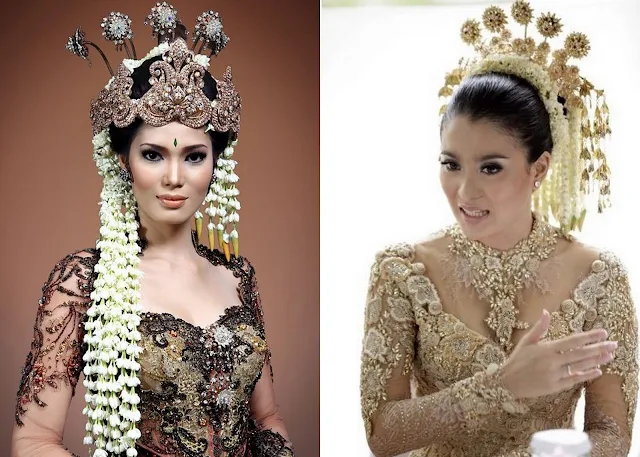West Javanese traditional clothes
West Java province that is closest to you, in addition to Java, with the capital city of Jakarta, has certainly experienced some things that strongly influenced the cultural life of the people. What else present, celebrating the West Java area ofPriyangan with West, East, Cirebon and Banten has contaminated the culture ofmodernity and his intercourse which began to move away from the culture andcustoms of the regions. So in terms of dress, the community of West Java province recorded experienced some major changes in the way of dressing.
This paper will try to expose custom clothing Western Java aspects of history and his philosophy that has been lost. Because if we are talking custom clothingWestern Java community imposed on this day, we will be distorted by a veryperceptible difference from various cities and counties found in West JavaProvince. This is caused by the war that occurred during the period of precolonial times to colonialism. Especially Japan are very hard to apply a rule inIndonesia, and transporting all kinds of food, and clothing.
In line with the existence of some value is missing, then the norm of any change.In between the norms about how to dress. In West Java on the colonial eraJapan bendo, headbands or almost in unison. Bun for mojang has replaced the braids, and the fabric is a switch on the kebaya dress that is considered more practical. The fact is, we can pull the conclusion that after the culmination point of the development of fashion in West Java occurred at the time of the end ofthe reign of the Netherlands East Indies. The book entitled Tatakrama OerangSoenda (Satjadibrata, 1946) contains some provisions how to dress in Sundanese (West Java) which is considered inappropriate at the time. How to dress that's generally made reference to traditional clothes West Java Society.
So this article will step up towards jungle history custom clothing Western Javacommunity rests on the results of the interpretation of evidence of historical evidence, either in the form of inscriptions, manuscripts, or oral literature ofwitness and the sign of keberadaat traditional clothing at the time.
Preliminary evidence indicating the existence of art craft weaving in West Javathere is in a Charter of copper Kebantenan written during the reign of SriBaduga Maharaja (1482-1521), the following excerpt in translation: "this isRahyang Niskala Wastu warning sign Kancana who descend upon RahyangNobility Kancana, similarly to the Susuhunan now in Pakuan Pajajaran. CapitalTitiplah in Jayagiri and Sunda Sembawa capital. There are people who givekesejahtraan. Don't be bothered by the tax collector, both cotton that's beenweighed or rice already shouldered ... "it is certain that the" cotton "mentioned in the Charter that is the raw material for making clothes.
Similarly, in the oral literature, in the folklore of West Java, we know the name ofthe Dayang Sumbi in the story of "Maras". Dayang said on character names that story were the clothing that comes from danghyang (material comparison"dang" in the story). Pardew sumbi literally means "a small piece of bamboo that is used for the border width of the woven" (Rig, 1862). So Dayang Sumbi were women honored that his works weave fabric.
From that assumption, meaning it's been since the first community in West Javato know the art of weaving tradition, keculi are applied to the area, but today we've not found it again. When in the Holster and Majalaya woven cap artificialrice Garut had until the middle of market dominate the Decade of the sixties.
Other information written on the book Sanghyang Torment Enclosure Karesianin 1518 in it memngungkap about the variety of shades woven, among them:Hibiscus muncang, spare handles, sameleg, seumat sahurun, cayut, sigeji, anyampasi-pasi, kalangkang sieve, poleng Clement, jayanti, cecempaan, paparanakan,nyengsoh, parigi, awi gaganjar, large, seam-lusian jayanti, rain, bestselling,gantina alus, and ragen panganten. In addition there is also a batik pattern, IE;pupunjengan, hihinggulan, kekembangan, alas-reason, urang-urangan,memetahan, sisirangan, root and flower tarate hata.
From the information above, it is clear that the tradition of weaving and batikwriting already known by people in West Java since the 15th century. Thisrefutes the assumption that States that the Sundanese tradition of new writingin the 17th century batik from Java. However it is very in sayangkan, Sundaneseis not capable of defending it, to disappear and not termusiumkan.
There is also a script to write Sundanese woman dress up prihal, is estimated to be written the beginning of the 18th century, on the Queen of Pakuan (Atja,1970). Here's the excerpt:
Disawur ku sekar suhun
Kangkalung deung tapok loop
Sigar de pameunteun (ng) beuheung
Shoulder Flash of the it katuhu
Geulang kancana ti ketja
Gorolong gumbrar homas kancana head is decorated by flowers
berkalung and skewer konde
enthroned and his neck is decorated
garnish the base of len

0 komentar